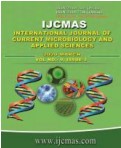


 National Academy of Agricultural Sciences (NAAS)
National Academy of Agricultural Sciences (NAAS)

|
PRINT ISSN : 2319-7692
Online ISSN : 2319-7706 Issues : 12 per year Publisher : Excellent Publishers Email : editorijcmas@gmail.com / submit@ijcmas.com Editor-in-chief: Dr.M.Prakash Index Copernicus ICV 2018: 95.39 NAAS RATING 2020: 5.38 |
The yearlings of Rohu (Labeo rohita) was fed with commercial pellated feed as T1(Control), feed incorporated with Lactobacillus sporogenes @ 4% as T2, Saccharomyces cerevisiae @ 4% as T3 and both Lactobacillus sporogenes @2% and Saccharomyces cerevisiae @ 2% as T4.The experiment was designed for 120 days in the cement tanks. Feeding was done with probiotics and without probiotics at alternate 15 days. Sampling was done at an interval of 15 days. The samples were analysed to determine the weight gain %, specific growth rate %, FCR, FER and TPC of probiotic microbes. The average initial weight of fish in all treatment was about 44 g. After feeding with probiotic incorporated feed, the weight increased to 150.78±0.68 gm, 176.13±0.75g and 183±0.91g in T2, T3 and T4 respectively as against 102.05±0.99g in T1(control). After first 15 days there were probiotic bacteria in all treatments except control. After next 15 days of feeding without probiotics, in all treatments (i.e. in 30 days) the TPC of probiotic microbe was found to be 0 in both T1 and T2 except T3 and T4. Likewise after 120 days the TPC of probiotic microbe in T1and T2 was 0,but in T3 the Saccharomyces cerevisiae was 2.38±0.02 x105 CFU/g and in T4 the Lactobacillus sporogenes was 0 and Saccharomyces cerevisiae was 2.70 ±0.008 x105 CFU/g.The growth in T4 was more due to more colony formation of Saccharomyces cerevisiae. Saccharomyces cerevisiae was found to colonized in the gut of fish after 15 days.
 |
 |
 |
 |
 |